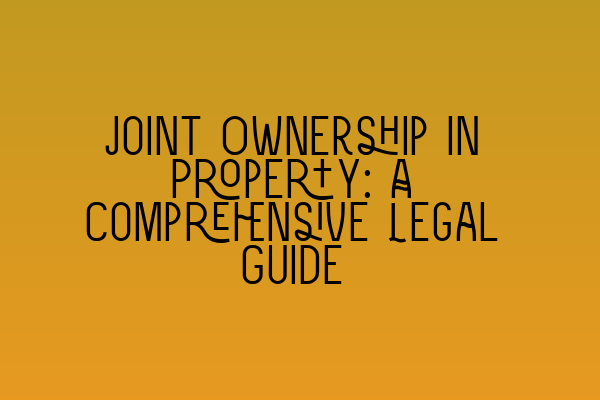Joint Ownership in Property: A Comprehensive Legal Guide
At SQE Property Law & Land Law, we understand that joint ownership in property can be a complex and confusing area of law. Whether you’re considering purchasing a property with someone else or already own property jointly, it’s essential to have a thorough understanding of your legal rights and obligations. In this comprehensive guide, we will explore the various aspects of joint ownership in property and provide you with the information you need to navigate this legal landscape with confidence.
Types of Joint Ownership
When two or more individuals co-own a property, there are two primary forms of joint ownership: joint tenancy and tenancy in common. Understanding the differences between these two types of ownership is crucial to comprehend your legal position and potential implications.
Joint Tenancy:
Joint tenancy is the most common form of joint ownership. In a joint tenancy, all parties jointly own the entire property, and there is a right of survivorship. This means that if one co-owner passes away, their share automatically transfers to the surviving co-owners. The property does not form part of the deceased’s estate and cannot be gifted or bequeathed in a will.
Tenancy in Common:
Tenancy in common, on the other hand, allows co-owners to have distinct shares in the property. Each co-owner maintains their separate share, which can be transferred, sold, or bequeathed in a will. Unlike joint tenancy, there is no right of survivorship, so a deceased co-owner’s share will pass according to their will or the intestacy rules if no will exists.
Determining the Type of Joint Ownership
When co-owning a property, it is essential to clearly specify the type of joint ownership. To establish a joint tenancy, the co-owners must fulfill the four unities: unity of possession, unity of interest, unity of time, and unity of title. These requirements ensure that all co-owners hold an equal, undivided interest in the property.
If the co-owners do not expressly state the type of joint ownership, the law presumes a tenancy in common. This default position can lead to disputes or unintended consequences. It is therefore advisable to clearly state the intended type of joint ownership in a legally binding agreement or declaration of trust.
Rights and Responsibilities
Understanding your rights and responsibilities as a joint owner will help ensure a harmonious and legally compliant co-ownership arrangement.
1. Equal Share of Ownership:
In a joint tenancy, all co-owners have an equal share and an equal right to possess and enjoy the whole property. This means that no co-owner can exclude others from accessing any part of the property. In a tenancy in common, the shares can be unequal and are determined by the co-owners’ agreement or contributions.
2. Contribution to Costs and Expenses:
Each co-owner is responsible for proportionately contributing to the costs and expenses associated with the property, including mortgage payments, maintenance, repairs, and insurance. It is advisable to have a written agreement or understanding detailing the contributions and responsibilities of each co-owner to avoid potential disputes.
3. Right of Partition:
In a tenancy in common, each co-owner has the right to seek a partition, which allows the property to be divided into separate portions or sold to realize the value of their share. However, a court may refuse a partition if it is impractical or unfair to one of the co-owners.
4. Consent for Sale:
In joint tenancies, all co-owners must give consent for the sale or transfer of the property. This is known as the “four unities of joint tenancy.” However, in tenancies in common, a co-owner can sell or transfer their share without the consent of the other co-owners.
Protecting Your Interests
To protect your interests, it is crucial to consider the following:
1. Cohabitation Agreements:
If you are cohabiting with someone and jointly own a property, a cohabitation agreement can outline the terms and conditions of your joint ownership. This legal agreement covers matters such as contributions, responsibilities, dispute resolution, and what happens in the event of separation or death.
2. Declaration of Trust:
A declaration of trust is a legally binding document that clarifies the ownership shares, contributions, rights, and responsibilities of each co-owner. It also addresses how the property should be divided or sold if necessary. Having a declaration of trust in place can provide clarity and protect your interests, particularly in tenancy in common arrangements.
3. Wills:
Reviewing and updating your will is crucial when co-owning property, especially in a tenancy in common. Clearly specifying how you wish your share of the property to be distributed upon your death can prevent disputes and ensure your wishes are respected.
Conclusion
Joint ownership in property is a complex area of law, but with the right guidance and understanding, you can navigate it successfully. At SQE Property Law & Land Law, our team of solicitors is experienced in providing comprehensive legal advice and assistance in matters of joint ownership. We can help you draft agreements, declarations of trust, and ensure your interests are protected.
To further support your legal education and preparation for SQE exams, we recommend checking out these related articles:
– SQE 1 Practice Exam Questions
– SQE 1 Practice Mocks FLK1 FLK2
– SQE 2 Preparation Courses
– SQE 1 Preparation Courses
– SRA SQE Exam Dates
We hope this comprehensive legal guide has provided you with valuable insights into joint ownership in property. Should you require any further assistance or legal advice, please do not hesitate to contact us at SQE Property Law & Land Law.
